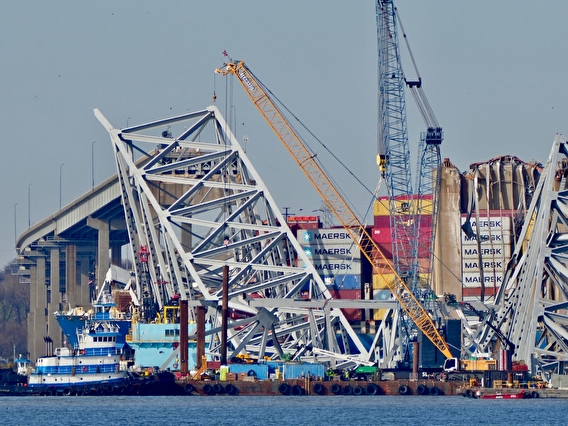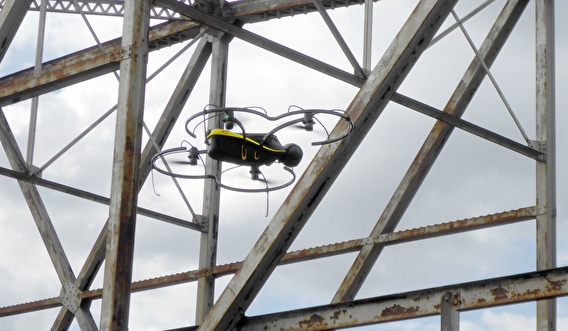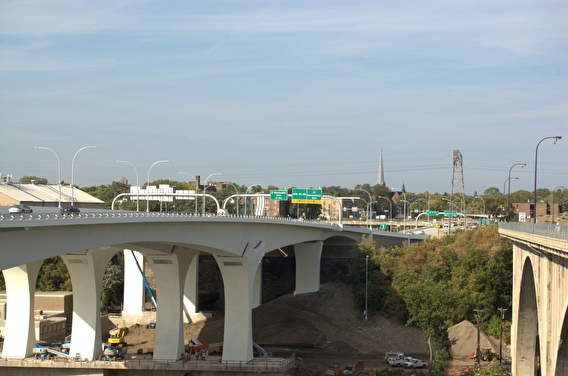By Alan Forsberg, P.E., Retired Blue Earth County Engineer

Minnesota needs functionally adequate, safe bridges. A wise person once said everything is worth nothing unless it is on the right side of the river.
Citizens were recently made more aware of bridge safety by the tragic collapse in March 2024 of the Francis Scott Key Bridge, in which six lives were lost. International shipping to the Port of Baltimore and regional truck and commuter traffic were halted. The Maryland governor estimated that more than 8,000 jobs were affected, and the economic impact was $15 million
per day.
Design, construction, and inspection have evolved
Bridge design and construction have evolved over decades to meet current load and width standards. Larger and heavier trucks and farm equipment require stronger, wider bridges. Often three generations of bridge foundations are found when a bridge is replaced—typically a timber or iron bridge for horse-drawn vehicles, a steel or concrete bridge for early motorized vehicles and farm equipment, and a steel or steel-reinforced concrete bridge for current traffic.
Bridge safety inspection has also evolved as inspection tools and methods are improved, inspection standards updated, maintenance problems identified, and systemic weaknesses revealed by bridge failures.
One such failure was the Silver Bridge collapse over the Ohio River at Point Pleasant, West Virginia, which killed 46 people in 1967. This disaster resulted in the creation of a federal bridge inspection program.
State and federal standards
State standards for inspection must meet federal National Bridge Inspection Standards (NBIS) or be more stringent.
Minnesota delegates the construction and inspection of local road bridges to cities and counties. Local government bridge inspection administrators and inspectors must be state-certified and meet training, experience, and testing requirements.
Bridges are inspected on a regular schedule depending on type and condition. Although local governments are responsible for performing, documenting, and reporting these inspections, the state is accountable to the federal government for meeting all NBIS requirements. Periodic federal and state audits ensure all bridges in the state are inspected in accordance with these rules. Inspection is a complex process requiring National Bridge Inventory (NBI) condition ratings of the bridge deck, superstructure, substructure, and channel and channel protection. Where applicable, ratings must also be assigned to large culverts.
In addition, each element of the bridge must be inspected and data entered into MnDOT’s Structure Information Management System (SIMS). The MnDOT Bridge Office is an excellent partner, assisting local governments with design, construction, and safety inspection. As the inspection process has evolved and become more complex, an increasing number of local governments have had to hire consultants or request MnDOT assistance with this work.
Major changes to the bridge safety inspection process
The inspection process has seen major changes over the years.
Database documentation
A federal computerized database of inspection, inspection methods, and load-rating data has been implemented and is regularly updated. Software database changes require continual training. For example, recent changes to the NBIS require a change from the old Recording and Coding Guide for the Structure Inventory and Appraisal of the Nation’s Bridges to the specifications for the National Bridge Inventory–Based on the SNBI. The Federal Highway Administration (FHWA) is currently developing an updated database system to incorporate this system (NBI NextGen). Over the next four years, MnDOT will be updating its inspection management data system and manuals and providing training and assistance to implement the new SNBI.

Improvements to safety inspection methods and field inspection tools
Examples of new inspection tools include drones, bridge access snooper trucks, 3D scanning, infrared scanning, ground-penetrating radar, and timber sounding devices. In the past, timber bridge inspection was mostly limited to visual inspection, sounding with a hammer, and coring. New tools include stress wave timers and resistance microdrills.
Learning from bridge maintenance problems
One example: In response to diagonal shear cracks found near reinforced precast concrete beams, University of Minnesota researchers tested a beam to failure in the lab, resulting in new recommendations for design and inspection.
The researchers found that bridge deck cracks and delamination from steel reinforcement were caused by corroding reinforcing steel. Additional concrete cover and epoxy-coated rebar were implemented to address this problem.
Learning from bridge failures
Bridge failures are tragic, but we have learned from them to construct safer bridges.
The New York State Thruway I-90 Schoharie Creek Bridge collapsed on April 5, 1987, resulting in the death of 10 people. After extensive investigation, it was determined that scour of riverbed material under a pier caused the collapse. Federal rules were issued requiring scour analysis of all bridges and design changes to ensure a safe foundation.
The recent high flows and flooding in Minnesota will result in monitoring scour depths around piers and, where appropriate, underwater inspection for all scour-susceptible bridges. Bridges in Minnesota susceptible to scour will have a plan-of-action report providing detailed instructions on monitoring and other steps to assure appropriate action is taken.

The I-35W bridge in Minneapolis collapsed during the evening rush hour on August 1, 2007, killing 13 people and injuring 145. The National Transportation Safety Board (NTSB) faulted excessively thin gusset plates and the additional weight of construction and maintenance equipment on the bridge. As a result, new inspection rules for all non-redundant steel tension member bridges were issued. Bridges for which the failure of one steel element in tension could result in the full or partial collapse of the bridge were thoroughly inspected and new design specifications issued.
In Baltimore, the collapse of the Francis Scott Key Bridge over the Patapsco River occurred when a large container ship, the Dali, struck one of its piers. The collapse resulted in the deaths of six maintenance men working on the bridge; two additional men were saved from the water. The bridge crossed one of the busiest shipping lanes in the United States and carried 34,000 vehicles per day, including 3,000 trucks. Plans are being developed to replace the bridge at a cost of about $1.7 billion to $1.9 billion. Emergency action led by the U.S. Army Corps of Engineers and including the Navy, Coast Guard, local authorities, and private contractors has removed the wreckage of the bridge, and the shipping channel is now open.
Once the NTSB concludes its study of the Dali collision, the FHWA will review the recommendations for new policy dealing with navigation vessels and bridge collisions. Some possibilities:
- More robust piers, fenders, and structural dolphins to stop or deflect vessels before they collide with a bridge.
- Use of tugboat(s) when vessels are passing under a bridge based on harbor configuration, wind speed, and vessel size.
- Redundant propulsion, electrical generation, and control systems on vessels.
Are Minnesota bridges safe?
The public can be assured all local government bridges are inspected as part of a thorough safety inspection program. Our bridges are safe, providing load postings are observed!